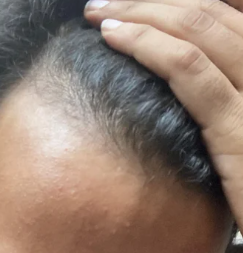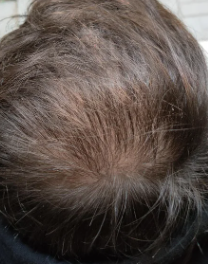Dr. Christine Shaver and other dermatologists are picking up diseases of the scalp in young balding men. These men present with itching, inflammation and hair loss. Upon biopsies taken by Dr Shaver, she identifies about one young male patient each week with a condition called Lichen Planopilaris or Frontal Fibrosing Alopecia, both autoimmune diseases of the scalp. In some men who eventually get a hair transplant, the hair transplant is likely to be rejected by the body. It may also reduce the growth or prevent growth in a hair transplant. If you have itching and inflammation, seek out a dermatologist and have two biopsies, one in the frontal where the inflammation and the itchiness is most prevalent and then a second biopsy from the Donor area in the back of the head. A biopsy read by an expert, will make the diagnosis and then special treatments are required. Catching it early is critical for everyone who has these diseases.
I was reading up on a few dutasteride studies and was curious what your thoughts were about the recommended dosage of dutasteride given it’s rather extended half life.
https://academic.oup.com/jcem/article/89/5/2179/2844345 for example.
Clark noted that the DHT suppression in patients after drug cessation for .5mg dutasteride only had a minor deteriation after 2 weeks with greater DHT in the following weeks, and I’m just wondering what the medical benefits would be from continuing on the recommended .5mg daily when there doesn’t appear to be a specific clinical benefit?
Just curious, not taking this as medical advice. I just have questions and no friends in medicine to ask.
This is a complex issue. Do you really want a 94% or high reduction of your DHT? The article indicates it is possible with dutasteride. The recommended daily dose is .5/day, but I suspect that same benefits might be reasonable at a dose of once a week but since I do not prescribe this medication, I would rather not weigh in on the dosing issue. Most articles I have read indicate that the DHT block is 85% with dutasteride and 70% with finasteride
I’ve been on finasteride for half a year and I’ve just started topical minoxidil (regaine) about a week ago, I’ve been applying it on my temples because that’s where my hair is thinning and receding, I don’t have any hair loss on other parts of my head. I found that using a few drops on each side already covers the whole balding areas and using any more makes it wet and drip down my forehead, so is it fine to just use enough to cover those areas even if it’s less than 1mL? Thanks
You don’t have to flood your scalp. Using the liquid, put if on the scalp in small drops and rub it in. Do it best after a hot shower before you go to bed
The difference is significant considering that both photos were taken after a #2 shave which means that the hair length is the same. To me as a doctor, it tells me that the miniaturized hairs in the top of your head have reversed significantly.
Photos lost, sorry
Hello doctor Rassman I have some questions about the use of minoxidil and derma rolling I have a 1.5mm derma roller and use minoxidil foam is 1.5mm too long? You can’t really find a definite answer on the internet how often should I derma roll on my scalp with a 1.5mm derma roller and how long should I wait before applying minoxidil after?
Frequency should be once a week and when you apply minoxidil. It should be rubbed into the open holes so it should be shortly after using the derma roller
Hello, my name is Ali. I wonder if you have any advice for me. I am 25 years old and took 1mg of propecia 5 and a half years ago (one tablet( because I was losing my hair. After taking the tablet I suffered side effects straight away, I developed gyno and have had persistent side effects ever since. The side effects include erectyle dysfunction, premature ejaculation and my semen is watery too compared to before. Over the course of 5 years my condition has improved slightly but the ED continues to persist. I have seen a doctor who sent me for a full blood and hormone check and everything came back normal. I am stuck to be honest, do you have any advice?
This is the first time I heard of this happening. I don’t know how to help you or what to make of your story
Dr do you know if finasteride sheds or shrinks some hair during the 2 months stage after a hair transplant?
No, the shed if it comes from finasteride is a sign that it is working. Possibly you are shedding some miniaturized hairs that will regrow in a few months, just a guess. I hope you were on finasteride when you had the hair transplant as that is critical
If you have a hair transplant do you need to take Fin still? Or are the donor hairs usually resistant to hair loss?
You should keep in mind that male patterned hair loss is progressive and finasteride does two things when having a hair transplant: (1) it protects against shock loss from the transplant (the loss of most of the miniaturized hairs present at the time of the transplant and (2) it slows down the progressive nature of the hair loss better than any other drug.
I’ve never really had hair problems, my parents have full heads of hair and barely anyone in my family has hair problems of any type. Last year I went through some very rough months which have left me with some anxiety and other problems and during those months I noticed a very drastic decline in my hair. Basically from full density, can’t see the scalp, to very dry, thin and low density hair. All my blood work is always fine, my testosterone levels are fine my vitamins are fine (got tested for vitamin d levels). Has anyone here experienced that?
In my 32 years practicing hair related conditions, I see stress as a major accelerator for genetic hair loss. It even hits people without genetic hair loss in presentations such as Telogen Effluvium which can reverse in time as stress reduces
Hi Dr Rassman, is your opinion still that one month should be adequate time to come off of Finasteride without risk of conception being more difficult or risk of fin in the semen causing deformities?
That is an educated guess! If we are talking about finasteride in the semen, then knowing that the blood half life is 4-6 hours (say 6 hours), the body fluids should have gotten rid of the finasteride within a week, so by saying a month, that should be a reasonable time frame.
I’ve been having hair loss and thinning for the past three years. I’ve taken minoxidil for a year and it didn’t really work. Some 4 months ago I got some blood work done and my vitamin D levels were low as well as my iron levels were too high. I was prescribed 50,000 IU vitamin D pill to take once a week for two months. I had amazing results in about 2 to 3 weeks. By the end of the two months, my hair was a lot fuller. Unfortunately once I was off those pills my hair started to thin and fall out. Not at the rate as before (hair on the pillow while I was sleeping, etc.) but 10-15 stands of hair while I wash my hair. I’m pretty bummed out about this. The doctor did tell me to maintain it with 1000 IU. But it hasn’t been helping. So I up my dosage to a higher safe level dosage of 4000 IU. It’s been about two weeks since I’ve been off of the 50,000 IU. At this rate, I’m not sure if it was the vitamin D level being the underlying issue of my hair thinning.
I have little doubt that many men or Vitamin D deficient makes hair loss worse. It is easy to take a Vitamin D capsule once a day to solve the problem. 50,000 IUs are a bit too high. Try to take 5000 every other day and that should build up your Vitamin D levels. Keep on that routine for life. I take 5000 IU every other day.
https://www.prnewswire.com/news-releases/amplifica-completes-11-8-million-series-a-financing-to-enable-clinical-development-of-lead-products-to-treat-androgenic-alopecia-301657072.html
Page 75 of 1234



